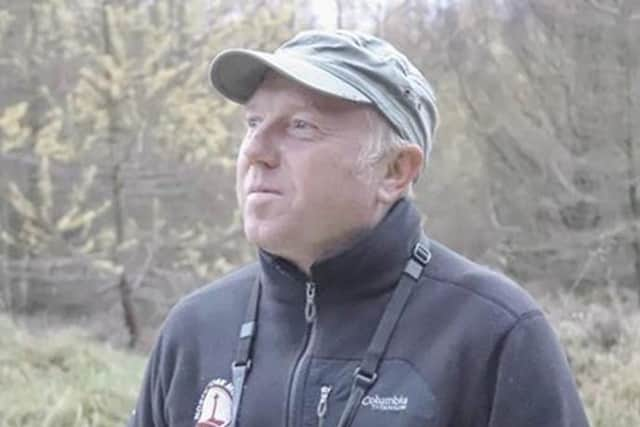Crusade to save the endangered Turtle Dove


Since the age of eight, ecologist Richard Baines from the North York Moors National Park Authority has developed a deep-rooted attachment to the natural world.
“I can still remember seeing them amongst a hedgerow on the way home from school – it left such a lasting impression,” he said.
Advertisement
Hide AdAdvertisement
Hide AdThe lure of such moments remain at the heart of his work, including his most recent efforts to save the UK’s fastest declining bird – the turtle dove.


This dainty creature, with its distinctive mottled feathers of golden orange and black is fighting for survival.
Richard leads the North Yorkshire Turtle Dove Project, a scheme funded by the National Lottery Heritage Fund, North York Moors National Park Authority and other partners to study, raise awareness, and advise local communities on ways of improving habitat for this threatened species.
Wildlife artist, Robert Fuller charts 'Bandita' the stoat as she turns white for winterBeekeeper Chris invents a new way to produce prize winning beeswaxI joined him on a visit to Cropton Forest to learn more.
Advertisement
Hide AdAdvertisement
Hide AdSitting alongside him, as we set off along the borders of the National Park, he was so at ease talking about his love of birds. He spoke of particular fondness for the gentle purr of turtle doves that he could instantly recognise.
His fascination with birds was instilled from an early age.
As a child he used to draw intricate sketches of birds, which his teacher encouraged. By recreating what lay before him with his hands, he was able to develop a deep understanding of the different parts of each bird.
After travelling through narrow country lanes, we eventually arrived at Cropton Forest. We set off by foot down a large path with blocks of conifers lining each side before arriving at Richard’s survey location.
Advertisement
Hide AdAdvertisement
Hide AdAs part of the project ecologists and volunteers are given a one-by-one kilometre spot that they return to in both the spring and summer to monitor turtle dove populations.
Richard moved calmly through the space as he headed down a path lined by young conifers, pausing for brief moments to peer into the undergrowth before moving on. He kept a quiet focus at all times, allowing moments to pass with ease.
A flutter among the leaves, a murmur among the shadows – he was attuned to it all. Considering only one turtle dove was found within this area in 2018, the ability to identify them requires a great deal of patience and knowledge. The tone of our conversation soon shifted as we delved into the growing threat to this iconic bird that has declined more than 95 per cent in the UK since 1970.
We have become so accustomed to such discussions that it now feeds our daily consciousness.
Advertisement
Hide AdAdvertisement
Hide AdThere is a continuous dialogue among the media that reminds us of the potential collapse of our natural world, but is this enough to drive an ecological revival?
To begin to address such questions it is worthwhile reflecting on the real value that turtle doves and birds can bring to our day-to-day lives to encourage us to act not only out of fear towards losing them, but by a clear acknowledgment of their significance.
Richard raised an interesting point towards how we consider ourselves as being separate to the natural world.
As humans we are conscious of our character, feelings, motives and desires – we are so self-aware that it is intrinsic to our nature to see ourselves as being different from one another and animals.
Advertisement
Hide AdAdvertisement
Hide AdAnd yet our survival is critically dependent on that of the natural world, from the air we breathe to the water we drink.
The boundaries are also blurred when we consider how we interact with birds.
We can be roaming the streets when a twitter or rustle amongst the hedgerows captures our attention. Such moments can offer a respite from the relentless focus we can all place upon our own lives – an opportunity to reflect, escape, smile.
We can also rest contentedly in the knowledge that such creatures don’t care about what we are wearing, the bills we have to pay or a recent failure at work.
Advertisement
Hide AdAdvertisement
Hide AdThey are blissfully unaware to all our worries, which allows us to grasp a necessary perspective.
Their existence is also so simple. The philosopher, Immanuel Kant, once said: “We are not rich by what we possess but by what we can do without” and at a time when our consumption levels are beyond sustainable it is worth reflecting on how little creatures, such as birds, need.
Their very presence is nothing more than a breath upon the earth, a passing wind drifting by – we should look to them as upholders of ideals we desperately need as we work towards a sustainable future.
This is why the work of Richard and the North York Moors National Park Authority is so important.
Advertisement
Hide AdAdvertisement
Hide AdAlongside a dedicated team of 70 volunteers, the project works alongside farmers and land managers to create new habitats and monitor population levels to help save this bird on the brink.
If you would like to learn more please go to: www.northyorkmoors.org.uk/turtledoves